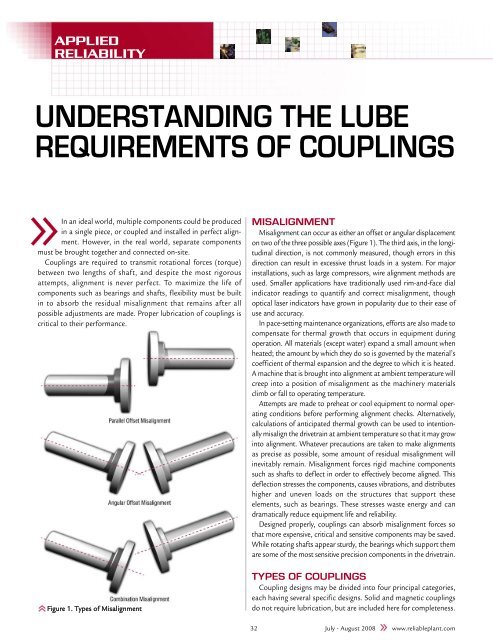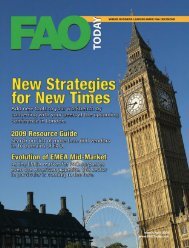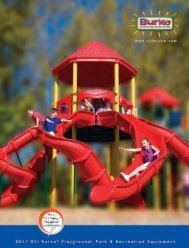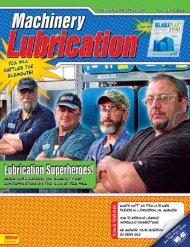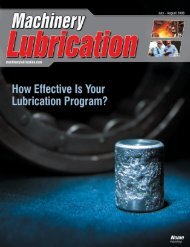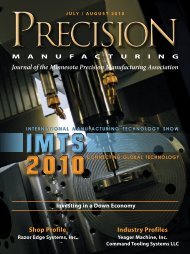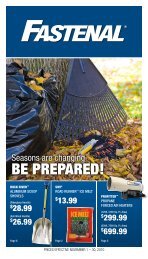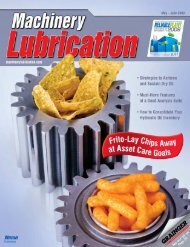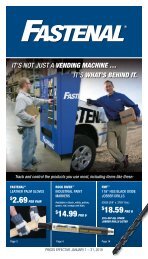Reliable Plant July August 2008
Reliable Plant July August 2008
Reliable Plant July August 2008
You also want an ePaper? Increase the reach of your titles
YUMPU automatically turns print PDFs into web optimized ePapers that Google loves.
APPLIED<br />
RELIABILITY<br />
UNDERSTANDING THE LUBE<br />
REQUIREMENTS OF COUPLINGS<br />
In an ideal world, multiple components could be produced<br />
in a single piece, or coupled and installed in perfect alignment.<br />
However, in the real world, separate components<br />
must be brought together and connected on-site.<br />
Couplings are required to transmit rotational forces (torque)<br />
between two lengths of shaft, and despite the most rigorous<br />
attempts, alignment is never perfect. To maximize the life of<br />
components such as bearings and shafts, flexibility must be built<br />
in to absorb the residual misalignment that remains after all<br />
possible adjustments are made. Proper lubrication of couplings is<br />
critical to their performance.<br />
Figure 1. Types of Misalignment<br />
MISALIGNMENT<br />
Misalignment can occur as either an offset or angular displacement<br />
on two of the three possible axes (Figure 1). The third axis, in the longitudinal<br />
direction, is not commonly measured, though errors in this<br />
direction can result in excessive thrust loads in a system. For major<br />
installations, such as large compressors, wire alignment methods are<br />
used. Smaller applications have traditionally used rim-and-face dial<br />
indicator readings to quantify and correct misalignment, though<br />
optical laser indicators have grown in popularity due to their ease of<br />
use and accuracy.<br />
In pace-setting maintenance organizations, efforts are also made to<br />
compensate for thermal growth that occurs in equipment during<br />
operation. All materials (except water) expand a small amount when<br />
heated; the amount by which they do so is governed by the material’s<br />
coefficient of thermal expansion and the degree to which it is heated.<br />
A machine that is brought into alignment at ambient temperature will<br />
creep into a position of misalignment as the machinery materials<br />
climb or fall to operating temperature.<br />
Attempts are made to preheat or cool equipment to normal operating<br />
conditions before performing alignment checks. Alternatively,<br />
calculations of anticipated thermal growth can be used to intentionally<br />
misalign the drivetrain at ambient temperature so that it may grow<br />
into alignment. Whatever precautions are taken to make alignments<br />
as precise as possible, some amount of residual misalignment will<br />
inevitably remain. Misalignment forces rigid machine components<br />
such as shafts to deflect in order to effectively become aligned. This<br />
deflection stresses the components, causes vibrations, and distributes<br />
higher and uneven loads on the structures that support these<br />
elements, such as bearings. These stresses waste energy and can<br />
dramatically reduce equipment life and reliability.<br />
Designed properly, couplings can absorb misalignment forces so<br />
that more expensive, critical and sensitive components may be saved.<br />
While rotating shafts appear sturdy, the bearings which support them<br />
are some of the most sensitive precision components in the drivetrain.<br />
TYPES OF COUPLINGS<br />
Coupling designs may be divided into four principal categories,<br />
each having several specific designs. Solid and magnetic couplings<br />
do not require lubrication, but are included here for completeness.<br />
32 <strong>July</strong> - <strong>August</strong> <strong>2008</strong> www.reliableplant.com


